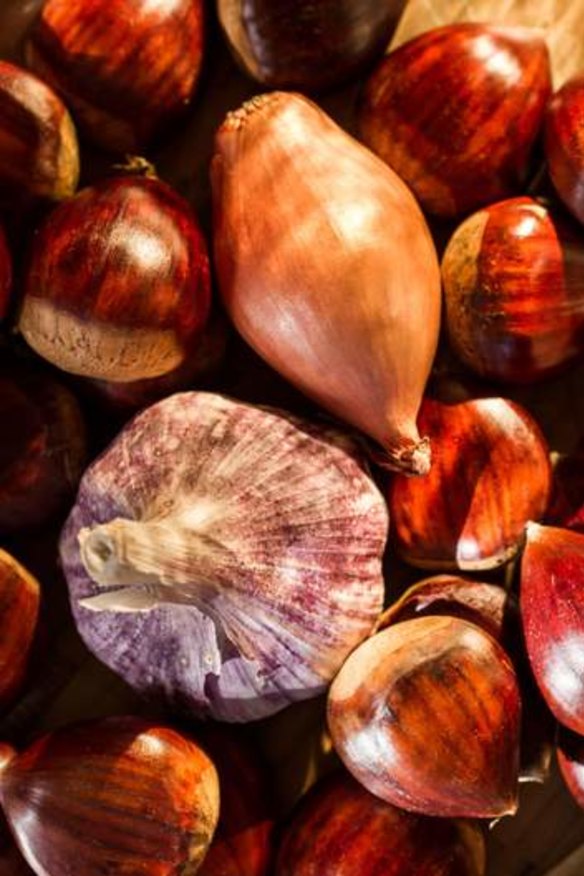Cold comforts

The very mention of chestnuts makes me look at the depleted wood pile with the usual guilt about yet another job not finished over summer, like the great big pile of mulch that doesn't seem to have spread itself over the garden beds.
Winter is coming and three chunks of knotty yellow box, a treated pine post and half a fence paling won't quite cut it.
I'm sure one of the more enduring images of people who work the land, apart from driving a red tractor and complaining about the weather, is that of a lean frame chopping firewood.
It's an image that makes me think of Clint Eastwood - the younger version rather than the crazy one talking to a chair.
Having neglected to collect a huge pile of wood again this summer, I'm on the phone to Yass firewood supplies for my usual well-seasoned red box order. And I have to take the sorry look he gives me each year, as if to say, ''Isn't there a man of the house?''
I always pay cash, so my life partner still sees me as the type of man who chops a huge pile of wood even though we don't have one red box on the property.
So chestnuts are my signal to rug up even though they really only seem right when roasted by a vendor on a street near Hyde Park in London - you know, Speakers' Corner, squirrels and Her Majesty. They have never tasted as good as the first time I had them there.
It's the same story with Nutella, bananas and crepes in Paris. Try as I might, I don't enjoy roasted chestnuts in the same way here, despite putting them in little brown bags and getting the kids to repeat lines from Dickens: ''You don't expect to be set up in a coach 'n' six and be fed turtle soup and venison.''
So I use chestnuts in dishes such as a stuffing for roast pork. Did someone mention pig? Now, there's another autumn flavour.
If you've raised pigs, you know it's the time you're going to have to sharpen the knives, as it's bacon time.
This recipe's a little Christmas-in-July, but it has a certain comfort to it, like the fire is going for the first time, the trees are shedding their leaves and you've just cut a tonne of wood.
The pickling is optional. It makes the pork roast well, the salt solution bringing out all its true porkiness. Also, if you use commercial pork, the salting will extract a fair amount of water, which they seem to be packed with. If you grow your own, you'll know what I mean.
On the way to making bacon, you first prepare pickled pork or green bacon. This allows the meat to take on the wood smoke and not dry up. If you pull the belly out of the brine early, it's a nice treat roasted. If you use a dry salt mixture just for a day or so, you get the same effect - intensified flavour and beautiful texture. You don't need any more salt in the recipe, it's all done.
Bryan Martin is a winemaker at Ravensworth and Clonakilla, bryanmartin.com.au
Roast pickled pork belly with chestnuts, sage and radicchio
600g pork belly, meatier section, skin scored with sharp knife
30g salt
50g sugar
12 chestnuts, cooked (see below)
2 tbsp pork fat or oil
½ head radicchio, sliced
3 eschalots, chopped
1 clove garlic, minced
3 sage leaves, sliced
1 tsp chopped fresh thyme
4 juniper berries, crushed
ground pepper
handful breadcrumbs
Rub the pork belly with salt and sugar. Leave for 12 hours to cure, then wash off.
To cook the chestnuts, score through the outer skin of each chestnut at the base, then roast in a heavy pan until they start to split, or boil for about 15 minutes. Peel - keep them warm wrapped in a tea towel, which makes them easier to peel.
Heat a little fat or oil and cook the radicchio until wilted, remove.
Saute the eschalots until soft, then stir in the garlic, and cook for a few minutes. Puree this with the chestnuts, juniper berries, herbs and spices.
Mix in the radicchio and breadcrumbs.
Lay the pork belly skin side down and cover the upper side with stuffing, roll up and tie at regular intervals with string. Push any extra stuffing into the edges.
Heat a suitable sized, heavy-based roasting tray and quickly cook all over on the stove top, then into an oven set at 130C for two hours, or until internal temperature reaches 75C.
Take out and rest for 15 minutes. Slice and serve with the sauce (below).
Sauce
1 cup dry white wine
½ cup madeira or amontillado sherry
¼ cup sweet red wine - muscat or pedro ximenez
1kg pork stock (see below)
Bring the wines to a simmer and reduce to a thickish quarter cup.
Add the stock and cook down to a sauce.
Pork stock
1kg pork bones
1 leek, chopped
1 onion, chopped
2 carrots, chopped
1 celery stalk, chopped
1 sachet of fresh thyme, parsley stalk, peppercorns and juniper berries
Roast the pork bones in a hot oven until well browned. Saute the vegetables until they start to colour, then add the pork bones and cover with water. Add the sachet. Simmer very gently for two to three hours. Strain.
The best recipes from Australia's leading chefs straight to your inbox.
Sign up